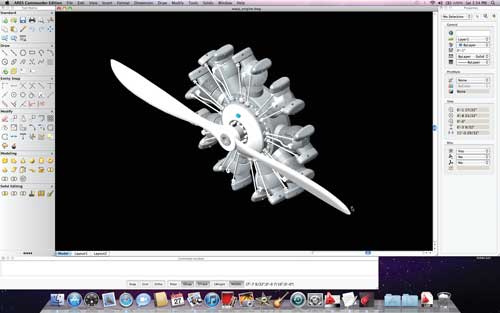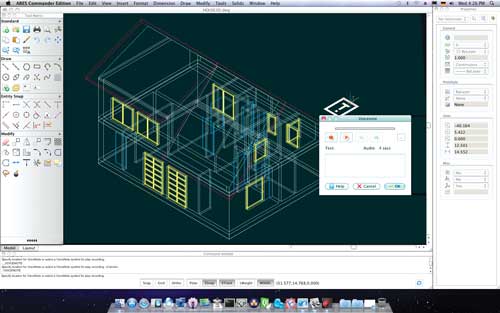Latest News
December 4, 2001
By David Cohn
With its launch last year, Graebert’s ARES Commander Edition for Macintosh became what the company calls the first “professional, multi-platform CAD solution for Mac, Windows and Linux,” its release predating the Mac version of AutoCAD 2011 by several months.
Graebert GmbH has a long history in the CAD industry. The company has been selling CAD systems since 1983, and was the first German distributor of AutoCAD. In 1994, Graebert developed its own CAD software, which was marketed as FelixCAD (later rebranded as PowerCAD). In 2005, the company replaced its existing CAD engine with an entirely new kernel, and ARES was born.
In addition to its own software, Graebert has partnered with Corel, which in April 2011 released CorelCAD for both Windows and Mac, based on Graebert’s ARES technology. Graebert is also the company behind Dassault Systemes’ DraftSight.

Graebert’s ARES Commander Edition for Macintosh has a native Mac interface, but its collection of tools will be instantly familiar to anyone who has ever used AutoCAD.
While ARES Commander Edition has a native Mac interface, its components are quickly familiar to anyone who has ever used AutoCAD. Across the top of the screen is a menu bar with pull-downs organized very similar to those in the “classic” AutoCAD interface (the old interface before the introduction of the ribbon). When first started, a Tool Matrix palette appears on the left and a Properties palette on the right, with a new drawing open in the graphics area. ARES Commander uses AutoCAD’s DWG as its native file format, and the software had no problem opening files saved in the AutoCAD 2010 or earlier file formats—all the way back to R12.
There’s also a Command Window similar to AutoCAD’s command line, located below the graphics area. Users can start commands by typing, with ARES recognizing most AutoCAD commands and command aliases. The Command Window also has buttons to toggle drafting aids such as Snap, Grid and Ortho modes. Each of these palettes can be floated anywhere on the screen or closed entirely. The Tool Matrix can also be minimized and individual toolbars dragged off the Matrix. The Tool Matrix initially displays four of the 25 available tool palettes.
Instantly Familiar
Like in AutoCAD itself, each drawing occupies its own window, with three tabs across the bottom to switch from model space to one of two initial paper space layouts. You can right-click on these to add rename, copy or delete layout tabs, and these tabs can be hidden and displayed just like in AutoCAD. In fact, ARES Commander Edition is so AutoCAD-like that it’s almost frightening. A few commands have different names—such as NOTE instead of MTEXT and PATTERN instead of ARRAY—but their button icons make them easily identifiable in the ARES interface. In fact, longtime AutoCAD users can still start any ARES command by typing their AutoCAD name or command alias.
Even the command options are nearly identical to AutoCAD, and they work much the same way. For example, when drawing circles, you can right-click to display familiar command options, such as 3Point, 2Point, TTR (tangent, tangent, radius), and TTT (tangent, tangent, tangent).
Although there is no equivalent to AutoCAD’s dynamic input, ARES does include most of AutoCAD’s other drafting tools, including polar tracking, object snaps (which ARES calls ESnap), and object snap tracking (referred to as ETrack). ARES’ object-snap glyphs are even similar in appearance to those in AutoCAD.
One difference in ARES is that commands and controls that have their own individual dialog boxes in AutoCAD—such as creating text styles and table styles, setting various drafting options such as snap and grid spacing, and establishing drawing settings such as units and coordinate systems—are all controlled from a single Options dialog.
But ARES’ workflow is very much like that of AutoCAD. You can right-click to display shortcut menus, zoom using the roller-wheel on a mouse, pan by pressing the roller-wheel, and orbit in 3D by pressing the shift-key and roller-wheel simultaneously. Surprisingly, Graebert does not appear to have incorporated gestures. You can zoom using a two-fingered swipe, but that appeared to be the only gesture available when using the touchpad on our MacBook Pro.
Limited 3D
ARES Commander Edition for Macintosh incorporates ACIS-based solids, so you can create primitives such as boxes, wedges, cylinders and spheres. There are also tools to create some mesh objects, such as ruled, revolved and tabulated meshes, but ARES lacks AutoCAD’s tools for creating mesh primitives—and the program has no surface-modeling capabilities.

ARES’ VoiceNotes allows users to embed audio recordings into drawings.
Working in 3D space in ARES Commander is also not nearly as refined as in AutoCAD. While ARES has tools for performing Boolean operations such as Union, Subtract and Intersect, and for manipulating objects using tools like 3D mirror, slice and thicken, ARES lacks AutoCAD’s dynamic UCS. To work in 3D space, you’ll need to manually reposition the user coordinate system (called the CCS in ARES). That also means that ARES lacks AutoCAD’s wonderful PressPull capability. And while ARES shows grips at various points on 3D objects, they only enable you to move the object. You can’t enlarge a 3D box, for example, by grip editing—and there’s no way to edit subobjects.
In fact, once you’ve created 3D objects, there appear to be very few ways to modify those objects. For example, after creating a solid box, when you select the box, only its general properties appear in the Properties palette. You cannot adjust its length, width or height, and although you can scale the entire box, you cannot stretch it in a single direction.
Mostly Compatible
ARES does provide surprisingly good support for AutoLISP, scripts and C++, and we had no problem loading and running numerous AutoLISP programs. ARES also provides interface customization similar to that of AutoCAD. It also supports user profiles. The software uses the same hatch patterns, linetypes and SHX text files as AutoCAD, so users should have no compatibility issues exchanging drawing files.
ARES also incorporates an interesting capability not found in AutoCAD: Users can insert audio recordings (called VoiceNotes) into a drawing. These recordings are embedded into the drawing and can be played back later. While AutoCAD indicates that DWG files saved using ARES were created in software not developed or licensed by Autodesk, AutoCAD had no problem opening drawings we created or edited in ARES. VoiceNotes appeared as block references with attributes, although of course AutoCAD could not play the embedded recordings. But after resaving those drawings in AutoCAD, those VoiceNotes played just fine again when we opened them in ARES.
Of course, there are a number of AutoCAD features missing from ARES Commander Edition. For example, there’s no support for sheet sets, fields, dynamic blocks, data extraction, parametrics or data linking. Also missing are tools not included in the first Mac release of AutoCAD itself, such as the Action Recorder, Batch Standards Checker and eTransmit.
For the most part, ARES Commander Edition for Macintosh shows a lot of promise. It’s a very serviceable CAD program with very good AutoCAD compatibility—and some interesting capabilities. With a price several hundred dollars below that of AutoCAD LT (which lacks AutoLISP), ARES could do quite well as a 2D alternative to AutoCAD. But its 3D capabilities are lacking. That, and numerous other shortcomings, currently places it well behind AutoCAD in most areas. Still, considering that ARES Commander Edition is also available for Windows and Linux, Graebert has done a very good job in this first release. It will be interesting to see what the company has in store in future versions.
David Cohn is the technical publishing manager at 4D Technologies. He also does consulting and technical writing from his home in Bellingham, WA. He’s a contributing editor to Desktop Engineering and the author of more than a dozen books. Contact him via email at [email protected] or visit his website at DSCohn.com.
For More Info
Graebert GmbH
Graebert ARES Commander Edition for the Mac
Price: $795
System Requirements:
- Operating System: Mac OS X v10.5.8 (Leopard) or v10.6.x (Snow Leopard)
- CPU: Intel processor
- Memory: 1GB RAM (2GB recommended)
- Disk space: 2GB free disk space for installation
- Video: 1024x768 display (1280x800 recommended)
Subscribe to our FREE magazine, FREE email newsletters or both!
Latest News
About the Author
David Cohn is a consultant and technical writer based in Bellingham, WA, and has been benchmarking PCs since 1984. He is a Contributing Editor to Digital Engineering, the former senior content manager at 4D Technologies, and the author of more than a dozen books. Email at [email protected] or visit his website at www.dscohn.com.
Follow DE





